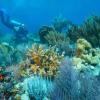Florida Travel: A Guide to Greek Food in Tarpon Springs
By VISIT FLORIDA staff
Sited a mere 30 minutes north of Clearwater, the coastal city of Tarpon Springs is famed for its Greek heritage. It was founded in the early 1900s by Greek sponge divers, eager to harvest the abundant, natural sea sponges that populate the Anclote River. Today, the city boasts the largest Greek community in the United States. This Greek village invites you to step back in time, to an era when the sound of bouzouki music fills the air-- along with the aromas of enticing Greek food.
Soaking up the Past
Sponges are the skeletons of small sea creatures brought up by hand from the ocean bottom. In the late 1800s, spongers working the Florida Straights and Gulf of Mexico came from Cuba, The Bahamas or Key West. Using small boats, one man rowed while another man looked into the water with a glass-bottomed bucket. When a sponge was spotted, he'd hook it with a long pole.
John K. Cheney built a warehouse in Tarpon Springs to handle sponges bound for New York, then hired Greek divers and a buyer, John Cocoris. A brass plaque at the Sponge Exchange on Dodecanese Boulevard honors Cocoris, who came from Leonidion, Greece, as the founder of the sponging industry in Tarpon Springs.
Cocoris went back to Greece and brought over sponge divers, diving engines, oxygen lines and rubber diving suits topped by bell-shaped diving helmets.
The men pooled their money and bought a large boat. On June 18, 1905 a diver was lowered overboard and walked for the first time on the bottom of the Gulf of Mexico, trailing oxygen bubbles and carrying a short rake to hook sponges. To the spongers in small hooker boats bobbing on the water's surface, mechanized diving must have seemed like an alien invasion.
For years Tarpon Springs ruled as the Sponge Capital of the World. At Spongeorama and The Sponge Factory, both located on Dodecanese Boulevard, you can watch a free movie showing sponging history.
In 1908 the Sponge Exchange started as a storage and auction site for sponges. Sponges are still sold here alongside new specialty stores and boutiques. Bring a camera to take a picture of friends next to a replica of a great white shark.
Blight in the 1940s wiped out the sponges and Tarpon Springs lost its Sponge Capital title. In the 1980s the sponges came back. Then blight hit the Mediterranean and wiped out sponges there so Tarpon Springs regained its title which it still holds today.
What may be the oldest tourist attraction on the west coast of Florida is near the Sponge Exchange. George Billiris, owner of St. Nicholas Boat Lines, said in 1924 his father Michael Billiris started giving boat rides to tourists during January and February when rich winter visitors were in residence.
A Thirst for Fun
Today the Anclote River, along the sponge docks of Tarpon Springs, churns with possibilities for boat rides. St. Nicholas Boat Line continues the family tradition, going out daily for half-hour cruises with a demonstration of traditional Tarpon Springs sponge diving.
A date to remember is January 6, the feast of the Epiphany. Tarpon Springs has the largest Epiphany celebration in the United States.
As part of the celebration, a Greek Orthodox priest throws a crucifix into the Spring Bayou in Historic Tarpon Springs, located just a few blocks from the Sponge Docks. Young men jump into the water, hoping to be the one who brings up the cross.
You can admire a statue of a boy holding up the cross in a courtyard next to St. Nicholas Greek Orthodox Cathedral on Pinellas Avenue. Built as a replica of St. Sophia in Constantinople, the church is open to visitors and has 23 stained glass windows of amazing beauty.
Downtown historic Tarpon Springs is lined with antique shops and restaurants. Stop by the Tarpon Springs Cultural Center, housed inside the old City Hall on Pinellas Avenue to find out about walking and bus tours plus see a film on Tarpon Springs history.
A city trolley goes back and forth between downtown and the sponge docks of Tarpon Springs. Both parts of town are meant for walking. Parking lots are numerous and all day prices are under five dollars.
Train buffs will want to visit the Atlantic Coast Line Railroad Depot on Tarpon Avenue, built in 1909. It was restored by the Tarpon Springs Area Historical Society and is now called The Depot Welcome Center. The old railroad line has a new use as the Pinellas Trail, 38 miles of paved trail running form St. Petersburg to Tarpon Springs and used by walkers and bicyclists.
Downtown Tarpon Springs has a winery. Stop by the Tarpon Springs Castle Winery for a wine tasting. Grapes are harvested from 42 different co-ops around the United States then bottled and labeled at Castle Winery.
Outside the Winery are fountains, tables and a courtyard shaded by greenery. A great place to take a break before heading out to discover more of what Tarpon Springs has to offer.
Sponge Speak
Wool sponges - Soft, silky, lasts for years. Use for bathing, washing cars and boats, sponge and faux finishes for painting.
Yellow sponges - More texture than wool, not as soft, lower cost. Good for general cleaning.
Grass or vase sponges - Used for display, as a planter, holds anything.
Finger sponges - Decorative, often used in aquariums.
Loofas - This is not a sponge but the dried part of a loofa plant. Often confused for a sponge.
























